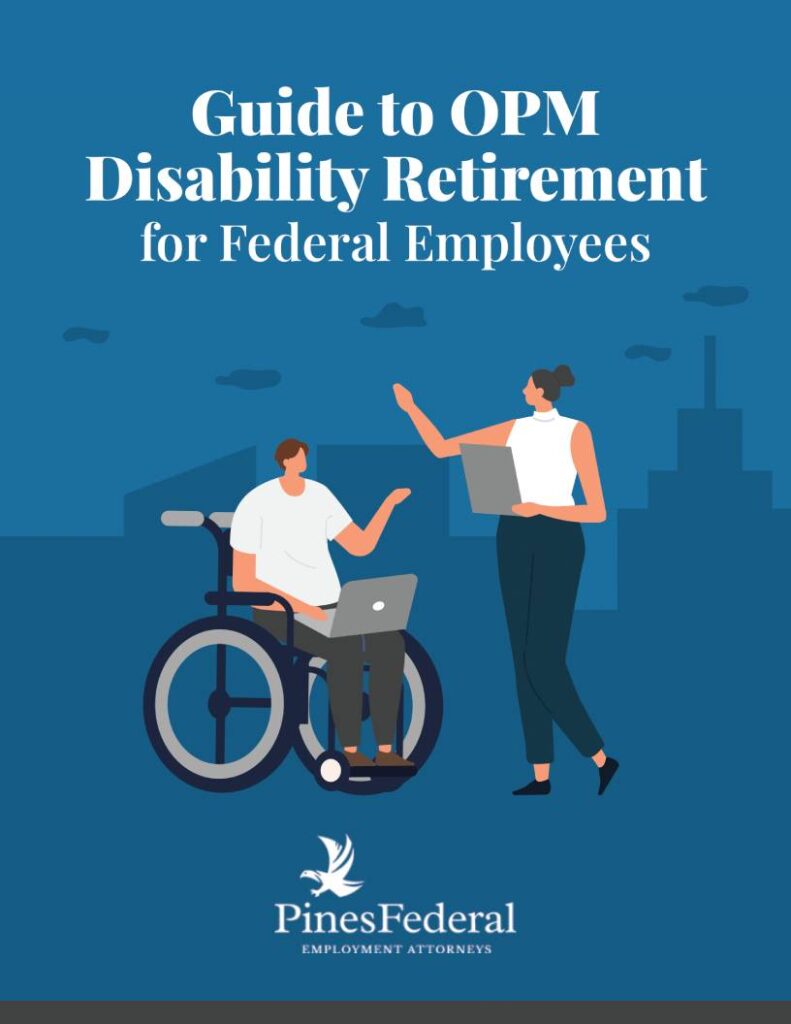Many people have difficulty understanding the difference between OPM disability retirement and Social Security Disability (SSDI). OPM disability retirement and SSDI can offer federal employees critical financial relief when a debilitating medical condition prevents them from earning a living.
Your livelihood and your family’s financial security can depend on understanding the relationship between these two programs and the support they offer.
Whether you have questions about either of these disability retirement options or don’t know which one you qualify for, our team at Pines Federal has the answers you need. If you have additional questions, get in touch with our team for guidance with your case.
If you need legal guidance with your OPM disability retirement case, contact us online or call (800) 801-0598 today for a case review!

“I highly recommend Pines Federal to any federal employee who needs legal representation. I am so grateful that I had [them] on my side. They are professional, trustworthy and dedicated to each individual’s case. They have a wealth of experience combined with their knowledge of federal employee rights to provide the client with the best possible outcome.”
What Is the Difference Between OPM Disability Retirement & Social Security Disability?
One significant difference between OPM disability retirement and SSDI is who is eligible for benefits.
Only federal employees within the Federal Employees Retirement System (FERS) can access OPM disability retirement benefits.
To be eligible for OPM disability retirement, you must also:
- Have worked 18 months of creditable civilian service in a role covered by FERS,
- Suffer a physical or mental impairment diagnosed by a healthcare professional,
- Expect to be disabled and unfit to perform job duties for at least a year, and
- Be unable to receive a job accommodation or reassignment from your agency.
By contrast, SSDI benefits are open to private employees across the country.
To receive Social Security Disability benefits, an employee generally must have:
- Paid Social Security taxes on their income,
- Worked for 5 out of the last 10 years, and
- Suffered a disabling health condition preventing work for at least a year.
To qualify for Social Security Disability, you must demonstrate that you have a “total” disability that enables you to perform any job (including your federal role). You can get one or the other or both types of disability retirement, however, there is a financial offset of benefits if you recover both.
Can You Get Federal Disability and Social Security?
Yes, federal employees can receive federal disability retirement and SSDI. In fact, the Federal Employees Retirement System (FERS) requires applicants to also file for Social Security Disability benefits.
Federal employees who fail to file for SSDI in addition to OPM disability retirement can have their federal benefits application dismissed. However, employees can still access OPM disability retirement even if they are not approved for SSDI benefits.
FERS requires require applicants to file for SSD since those who suffer from “total” disability may qualify for both benefits; however, an offset may occur.
What Does “Offset” Mean When Receiving Multiple Benefits?
An offset occurs when one benefit program’s payment can reduce another’s. This means that you will not be able to receive “double” benefits from OPM disability or SSDI.
It is important to note that an offset between benefits can vary and change yearly. It is essential to consult with an attorney when calculating benefit payments and eligibility.
How Can I Collect Federal Disability Retirement and Social Security Disability?
If you are approved for SSDI in addition to OPM disability retirement, you may receive benefits from both programs for some time.
For example, during the first year of your disability, you would generally receive monthly SSDI payments and disability payments from OPM (usually 60% of your three-year-average high salary, or “High 3”).
However, your payments from OPM will be reduced by 100% of the amount you have received from SSDI already. Consider a federal employee with a High-3 monthly salary of $6,000 who is approved for $2,000 a month in SSDI benefits.
During the first year of disability, FERS would pay them $1,600 monthly in federal disability retirement. That’s 60% of their monthly High-3 minus 100% of the value of the SSDI payment.
However, after the first year, calculating the FERS disability retirement and Social Security offset looks slightly different. From year two onward, federal employees can typically expect 40% of their High-3 minus 60% of their SSDI every month. Our example employee may still receive $2,000 from Social Security each month. However, now their FERS payment would be $1,200 per month.
Keep in mind that these are estimated calculations applied to typical cases. It is crucial to speak with a skilled federal employment lawyer to get an accurate understanding of your potential benefits and offsets.
Can I Receive Social Security Disability & Workers’ Compensation?
Yes, you can receive both federal worker’s comp and Social Security Disability benefits, but there may be a benefit offset. It is best to speak with our team to understand your options.
Can I Still Work While Receiving OPM Disability Benefits?
Yes, you can find employment in the private sector, as long as the new position doesn’t exceed your medical restrictions.
OPM may require employees to submit updates about the progression of their condition to remain eligible for benefits. This can include undergoing periodic examinations from a medical professional at the request of OPM.
Your benefits may also stop if your annual outside income exceeds 80% of the rate of basic pay you received in your previous federal role. However, as long as your wages and self-employment income remain below that amount, you may continue to receive OPM disability benefits.
Can I Still Work While Receiving Social Security Disability Benefits?
You should contact your local Social Security Administration (SSA) office to determine if you can still work while receiving Social Security Disability benefits.
The Social Security Administration (SSA) may allow employees who return to work to collect SSDI benefits for up to nine months. This is called a “trial work period.” These nine months are counted within a five-year period and don’t have to be consecutive.
During this time, eligible employees can receive full SSDI benefits and have no limits on the amount of income they can earn. However, they are required to report their ongoing work activity and income to the SSA to maintain eligibility.
After this nine-month trial period, the SSA may grant an employee an “extended period of eligibility” (EPE) during which they may work and continue to receive SSDI benefits. This period can last up to 36 months.
However, if an employee exceeds the EPE monthly earnings limit, they may be unable to receive disability payments in a given month. In 2024, the EPE earning limit is $1,550 per month for non-blind employees and $2,590 for individuals who receive disability due to blindness.
I am 59 Years Old and Currently on OPM Disability Retirement. Will I Switch to FERS Automatically When I Turn 62?
Yes, your OPM disability retirement benefits will switch to Federal Employees Retirement System (FERS). It will occur automatically whether you desire it or not.
However, your benefits will still be calculated at the same retirement rate and will include your creditable years of service as if you continued to work.
What Should I Do If I Need Help Applying for OPM Disability?
If you need help applying for OPM disability, you should contact our team at Pines Federal. With over 60 years of combined experience in federal employment law, we have the knowledge needed to help you with your disability claim.
Depending on the circumstances, you may be eligible to file if you were terminated from your position. Remember though you only have one year to apply for your benefits.
If you have a disability and are seeking benefits or have applied and were denied, we can help you. Our goal is to help you obtain approval of your claim at the initial application stage so you can avoid the stress of filing time-consuming appeals.
Contact our federal OPM disability retirement attorneys online or call (800) 801-0598 today to schedule a case review!
[DOWNLOAD] OPM Disability Retirement for Federal Employees
